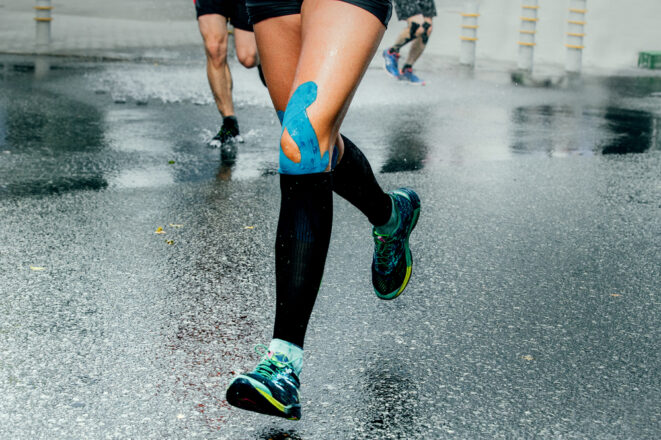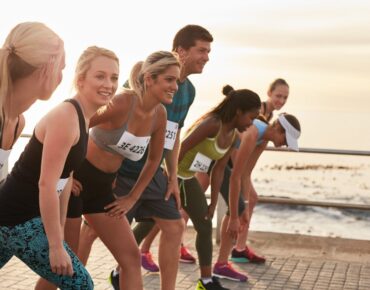Painful kneecap after a run? It’s likely caused by the runner’s knee. Runner’s knee refers to several conditions, all of which cause dull pain around the patella or kneecap. It’s common among long-distance runners because running puts repeated stress on the knee joint.
Knee injuries are the most common leg injuries in runners, affecting up to 30% of women and 24% of men. Runner’s knee is more common in women than men. It’s most likely to occur in mid-life women who’ve been running for many years.
Read on to learn more about this condition, what causes it, how to treat it, and what you can do to prevent it.
In This Article:
What Is Runner’s Knee?
Runner’s knee, also known as patellofemoral pain syndrome, is most commonly described as dull pain around the front or center of the knee. It occurs where the knee connects with the lower thigh bone or femur. Runner’s knee is not the result of tissue damage.
When you bend or straighten your knees, the kneecap or patella slides back and forth inside a grove at the top of the femur. This is called the patellar groove.
Runner’s knee occurs when your kneecap moves off to the side when you run or exercise instead of remaining in its grove.
It’s important to remember that this isn’t just one condition, but a broad term used to describe knee pain after running. Conditions that may contribute to runner’s knee include patellofemoral malalignment, iliotibial band syndrome, chondromalacia patella, and anterior knee pain syndrome.
Also, despite its name, it’s not only runners who can have it. But it commonly develops in runners as a result of the constant strain put on the kneecap and nearby structures, and especially as a result of overtraining or certain gaits.
Patellofemoral Pain Syndrome vs Patellar Tendonitis
Unlike runner’s knee, patellar tendonitis causes pain under the kneecap, where the patellar tendon meets the bone of the shin. It may occur as a result of strain on the tendon and tends to get better with rest.
As a runner, you may develop either or both conditions. But knowing the difference between them is important as it will help you treat the pain accordingly.
Causes of Runner’s Knee
Research indicates that mature female runners between the age of 40 and 60 have more internal rotation in the knee and higher movement inside out of the hindfoot compared to female runners aged 18 to 24. This contributes to the development of the runner’s knee in mature female runners.
But while some people may be predisposed to runner’s knee, the condition is usually triggered by causes that are at least partly under your control.
The typical causes of runner’s knee include:
- Weak hips and inner quads – Runners tend to have stronger hip flexors than posterior hip muscles. This makes the femur rotate inward and the kneecap strike the groove of the femoral edge, increasing the risk for knee pain.
- Knee injury or knee damage from a fall or blow
- Tight hamstrings or hips – These can also lead to knee pain unless you work on your overall flexibility.
- Gait and posture (overpronating) – Running with the feet rolling in or having fallen arches or hypermobile feet or overpronating.
- Training errors – Running or training too much too soon.
- Misaligned bones from the hips down – This results in more pressure in some parts of the legs as you use them, leading to less-than-optimal movement of the kneecaps.
- Arthritis
Risk Factors
Having a high weekly mileage and training intensely for long races increases the risk for the runner’s knee.
Other risk factors you need to pay attention to include:
- High body weight – Being overweight puts more strain on your legs and knees.
- Overuse and overtraining of knees – Very intense runs and high-stress exercises increase the load on the patellofemoral joint and can strain and irritate the tissues around the kneecap regardless of structural factors in a joint.
- Poor hamstring flexibility – Not adding flexibility exercises to your running plan can increase the risk for this condition.
- Underdeveloped thigh and hip muscles – Working these muscles out more frequently reduces the risk. A study of military recruits indicated weak thigh and hips muscles as the highest risk factor for patellofemoral pain.
- Being female – Women’s natural knee alignment angle and wider hips puts them at higher risk, especially in the case of mature women who run long distances.
- Bad footwear – Having flat feet can increase discomfort in the patella when running.
Symptoms of Runner’s Knee
Dull knee pain is the most common symptom of a runner’s knee. It may occur during or soon after a run.
You may feel this pain when walking, climbing stairs, exercising, or sitting with your knee bent. You may also feel it when getting down from the bed in the morning or or anytime you bend your knees.
Other signs of runner’s knee may include:
- Swelling around the knee
- Grinding or clicking sound in the knee
- Kneecap that is tender to touch
Good to know: When you feel the pain around the outside of your knee, you may suffer from iliotibial band syndrome. The iliotibial band is a connective tissue running from your hip to your shinbone and which helps with hip movements.
Treatment of Runner’s Knee
Runner’s knee can often be treated at home. Here’s how to cure a runner’s knee without having to visit your doctor.
- Rest to avoid repetitive stress on the patella and nearby tissues and allow these to recover. This means no running for at least several days.
- Apply ice to the knee for half an hour every 4 hours for up to 3 days to reduce swelling and pain.
- Keep your feet above the level of your heart by placing a pillow under them as you rest.
- Get a runner’s knee brace or use an elastic bandage or kneecap strap to provide your knee with extra support.
- Use shoe orthotics to improve your posture and reduce pain when walking or doing light training.
- Do physiotherapy exercises including standing quad stretches or wall slides.
The R-I-C-E plan often works well in dealing with reoccurring runners’ knee—Rest, Ice, Compress (with elastic bandage or brace), and Elevate your leg.
Good to know: It takes on average 2 to 6 weeks to recover from a runner’s knee, during which you need to take it easier with your running and training.
If the pain is severe, you can take ibuprofen, but it’s best to discuss this with your doctor first.
How to Prevent Runner’s Knee?
There are quite a few things you can do to prevent runner’s knee including adding stretching and quad-strengthening exercises to your workout.
A systematic review of studies conducted on iliotibial band syndrome in runners indicates that improving running style and hip and knee coordination helps treat and possibly prevent runner’s knee.
Here are some more tips on how to prevent a runner’s knee from coming back:
- Increase your weekly mileage gradually, without pushing yourself too hard.
- Do stretching exercises that improve your flexibility such as running lunges, figure-four stretches, and stretch and foam rolls.
- Toughen your quads with strength exercises such as straight leg raises, donkey kicks, and clamshells.
- Use knee protection for runners.
- Upgrade your running shoes and get arch supports or orthotics.
- Customize your workout to avoid repetitive strain on your knees if you already do long-distance running.
- Do recovery runs and stay active after intense runs to ease your body into recovery rather than stopping suddenly without a cooldown.
- Keep using a runner’s knee brace for extra support while you run.
- Reduce the impact on your knees by leaning forward and bending your knees.
In the end, the runner’s knee can be a sign that your body is sending you so you can take it easier and vary your training routine.
It can be painful, but it won’t stop you from running if you treat it adequately and try to prevent it.
It may keep you knee-deep in rest for a while, but it won’t bring you to your knees!
References:
- Arroll, B. and Edwards, A., 1999. Runner’s knee: what is it and what helps?. The British Journal of General Practice, 49(439), p.92.
- Pretorius, D.M., Noakes, T.D., Irving, G. and Allerton, K., 1986. Runner’s knee: What is it and how effective is conservative management?. The Physician and Sportsmedicine, 14(12), pp.71-81
- Yeung, E.W. and Yeung, S.S., 2011. Runner’s Knee. Evidence‐Based Orthopedics, pp.853-861.
- Klauser, A.S., de-Koekkoek, F., Schwabl, C., Fink, C., Friede, M. and Csapo, R., 2022. Intraobserver Assessment of Shear Wave Elastography in Tensor Fasciae Latae and Gluteus Maximus Muscle: The Importance of the Hip Abductor Muscles in Runners Knee Compared to Healthy Controls. Journal of Clinical Medicine, 11(13), p.3605.
- Tschopp, M. and Brunner, F., 2017. Diseases and overuse injuries of the lower extremities in long distance runners. Zeitschrift für Rheumatologie, 76, pp.443-450.














